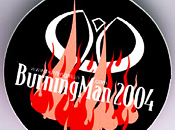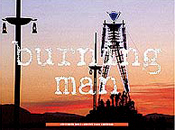The projects undertaken by the Print Production team in 2004 were the same as those in 2003: the Burning Man ticket, ticket mailer, Thank You card for volunteers and staff, the Survival Guide, the Burning Man Journal summer newsletter, stickers, the 2004 Census, and the WhatWhereWhen event listing. We have learned over time that working with the same pool of artists, designers, and content providers helps to smooth production. In 2005, we are looking to increase the pool of contributors for future projects.
 This year we shook things up with the Survival Guide and the Journal. We recruited a number of new writers and a new designer for the Journal. The finished piece was beautiful and set the bar a bit for 2005. Due to other priorities on the Project, some articles were written late, causing the Journal to be mailed extremely late and therefore reducing its effectiveness as a public communication tool. The theme text, which plays a central role in the Journal content, has already been published for 2005, allowing production to start in February.
This year we shook things up with the Survival Guide and the Journal. We recruited a number of new writers and a new designer for the Journal. The finished piece was beautiful and set the bar a bit for 2005. Due to other priorities on the Project, some articles were written late, causing the Journal to be mailed extremely late and therefore reducing its effectiveness as a public communication tool. The theme text, which plays a central role in the Journal content, has already been published for 2005, allowing production to start in February.
We learned that recruiting of writers must continue as an ongoing effort rather than on deadline for individual projects. Our timelines for all print production generally run tight and fast, so recruiting on a project basis did not allow us the time we needed to do a proper job of it. We also learned that active listening and communication of expectations are essential to developing shared vision and mutual understanding towards identifying the appropriate writers.
The Survival Guide underwent its most rigorous reworking in several years for 2004. The content was reviewed with renewed scrutiny, and the order of presentation was reorganized to highlight important issues the Project wanted to bring to the attention of participants. We redesigned the page layouts to keep the read bearable for those who have been receiving the Survival Guide year after year. We increased the number of pages to improve overall readability, but we added very little new content this year. As usual the content from 2004 will be reviewed, scrubbed and updated for 2005.
 The Black Rock City census took on a new life this year. The project was spearheaded by a new team member, and based on her success, she may be leading the census project in the years to come. She revamped the question content and the look of the census flyer. For the first time, we printed the census rather than photocopying it, with beautiful results. A new Census team took form over the summer and worked diligently on the playa to disperse census forms from Playa Info.
The Black Rock City census took on a new life this year. The project was spearheaded by a new team member, and based on her success, she may be leading the census project in the years to come. She revamped the question content and the look of the census flyer. For the first time, we printed the census rather than photocopying it, with beautiful results. A new Census team took form over the summer and worked diligently on the playa to disperse census forms from Playa Info.
 The stickers presented the same challenges and fun they do every year. It’s a fun project because it is an expression of pure thanks and appreciation to participants and the volunteer corps. The stickers are printed in August in Portland and Oakland. Operations are often running in the desert before they are off the press, so it’s always an adventurous ride to bring them to Gerlach.
The stickers presented the same challenges and fun they do every year. It’s a fun project because it is an expression of pure thanks and appreciation to participants and the volunteer corps. The stickers are printed in August in Portland and Oakland. Operations are often running in the desert before they are off the press, so it’s always an adventurous ride to bring them to Gerlach.
We were particularly happy with this year’s window sticker, which was handed out with the Greeter material. We are considering the suggestion to include the window sticker with ticket orders in 2006 to ensure more secure delivery to participants, rather than collating them with material participants receive on the playa.
Production of the WhatWhereWhen guide was particularly great this year, as we had the pleasure of hosting a post-graduate student as an intern. She took charge of approving posts and editing the raw material into the final format.
We had a great year, although our timelines often ran late and we had to push deadlines forward. In 2005, we anticipate greater efficiency in review and editing of content. We will be creating a large pool of regular contributors.
For additional information about each of the pieces that the Print Production team produces, please see the 2003 AfterBurn report for Print Production.
After the event in 2003, participants could finally live the Burning Man experience every day of the year, even off the playa. In the summer of 2003, the Burning Man Project printed the first-ever Burning Man Calendar. The concept had come up several times over the years; it was something that many of us wanted for ourselves, and at last the timing was right. If anyone was going to make a calendar, the Project wanted to make it ourselves, so we created a small team from our staff with design, management, and photo talent to undertake the experiment. A good portion of the office staff (and anyone else that happened to walk into the office during production) was asked to give input on the content and layout of the calendar. The challenge of producing something for the use and enjoyment of our very talented and diverse community was quite a daunting one, and the team’s commitment included conference calls at 4 a.m. and many all-nighters at the office.
We knew that a calendar created for the Burning Man community couldn’t be just any boring calendar; it had to reflect the colorful, artful and unusual experience of the event. In a daring move that honors the passage of time for members of our community, we built a Burn-year calendar that started in September after the event and followed the 12 months through the following August, when most are preparing for their trip to desert. Instead of a standard (boring) design with one photo on each page, the days and weeks in each month were interspersed with images to create a working calendar that also encouraged the user to think outside the box, so to speak. Each spread of the calendar featured a half dozen or so images along with a sprinkling of Burning Man history and other influential date-related factoids from patents, art history, literature, film, music, and counterculture events. In total, the calendar had 89 images contributed from 32 different photographers with photos from 13 of the (then) 17 years that the Man has burned. It even included a shot of the very first burn.
 Due to the success in 2003, the Project agreed to produce it again for 2004. The community really liked the calendar, and we were delighted to hear comments and stories such as participants staring longingly at their calendars during the cold winter months while trapped in cubicles in the default world. We printed the calendars through a participant connection in Reno and distributed them only via our website and a small network of walk-up ticket outlets. Limited distribution ensured that the calendars were available to our community without the transaction becoming a commoditized experience. We learned that in the future we need to produce the calendar earlier in the year. The change will help protect our own sanity during the hectic time immediately before the event, and it will make calendars available to participants before time to leave for the playa, as many folks want theirs available upon their return home. We also requested and received feedback on the content, layout, and usability, which will be taken into consideration the next time around.
Due to the success in 2003, the Project agreed to produce it again for 2004. The community really liked the calendar, and we were delighted to hear comments and stories such as participants staring longingly at their calendars during the cold winter months while trapped in cubicles in the default world. We printed the calendars through a participant connection in Reno and distributed them only via our website and a small network of walk-up ticket outlets. Limited distribution ensured that the calendars were available to our community without the transaction becoming a commoditized experience. We learned that in the future we need to produce the calendar earlier in the year. The change will help protect our own sanity during the hectic time immediately before the event, and it will make calendars available to participants before time to leave for the playa, as many folks want theirs available upon their return home. We also requested and received feedback on the content, layout, and usability, which will be taken into consideration the next time around.
The calendar project was an experiment in part because it is really the first and only product produced by the Burning Man project (besides a few t-shirts and omitting the videos and books that were created by individuals). Money is needed to produce something of this scale, and the calendar is considered a self-funding art project. If enough calendars are sold to cover the cost of making them, then the Project will keep producing them. If a little extra cash comes in from the sales, great — as always the Project can use it — but the project is mostly about the joy of seeing the calendars on our own walls and the hopes that like us, others are enjoying their memories of Burning Man all year long.
Submitted by,
Jess Bobier and CameraGirl


